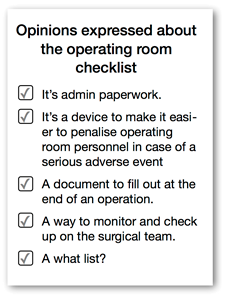 We make a practice of asking this question every time we work with operating room personnel. The range of responses that we’ve had so far is a perfect illustration of the absence of training, or simply lack of information, about checklist use.
We make a practice of asking this question every time we work with operating room personnel. The range of responses that we’ve had so far is a perfect illustration of the absence of training, or simply lack of information, about checklist use.
Our experience in aviation gives us a totally different outlook on this tool. We wouldn’t contemplate for a moment starting a flight without a checklist, not because it’s compulsory to carry one, but because it’s essential. Checklist use has saved thousands of lives in aviation.
It’s both a line of defence against errors and an aid to briefing
Checklists are designed for one purpose only – to ensure that all the essential steps of a procedure are dealt with. They don’t question the professionalism of the operators; they complete it by acting as a secondary line of defence. A team can be said to have synergy when the actions of the members are coordinated towards a single shared goal. Going through the checklist is a special time of information-sharing, which gives everybody the opportunity to make a vital contribution. It prompts them to use a protocol to secure communication, and it’s an aid to team briefing. The checklist is much more than a simple formality for administration or statistics.

